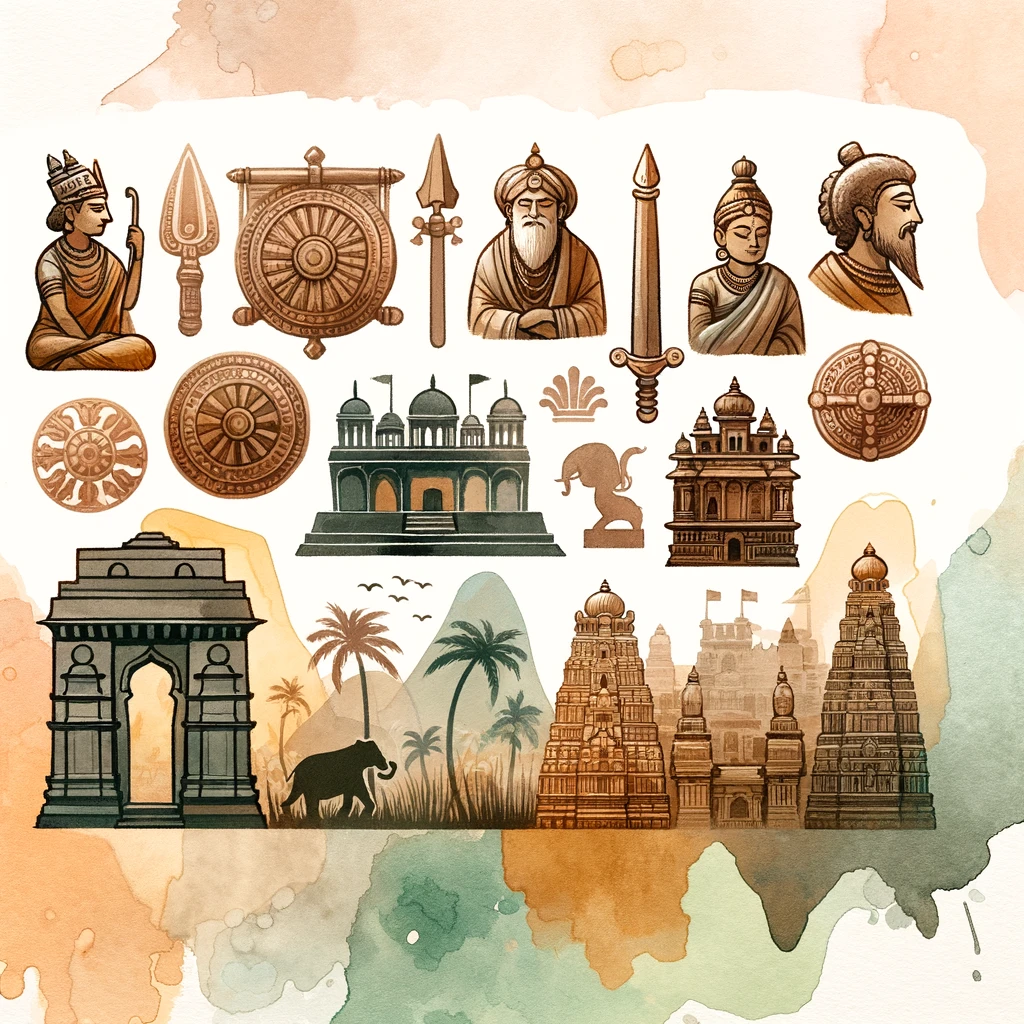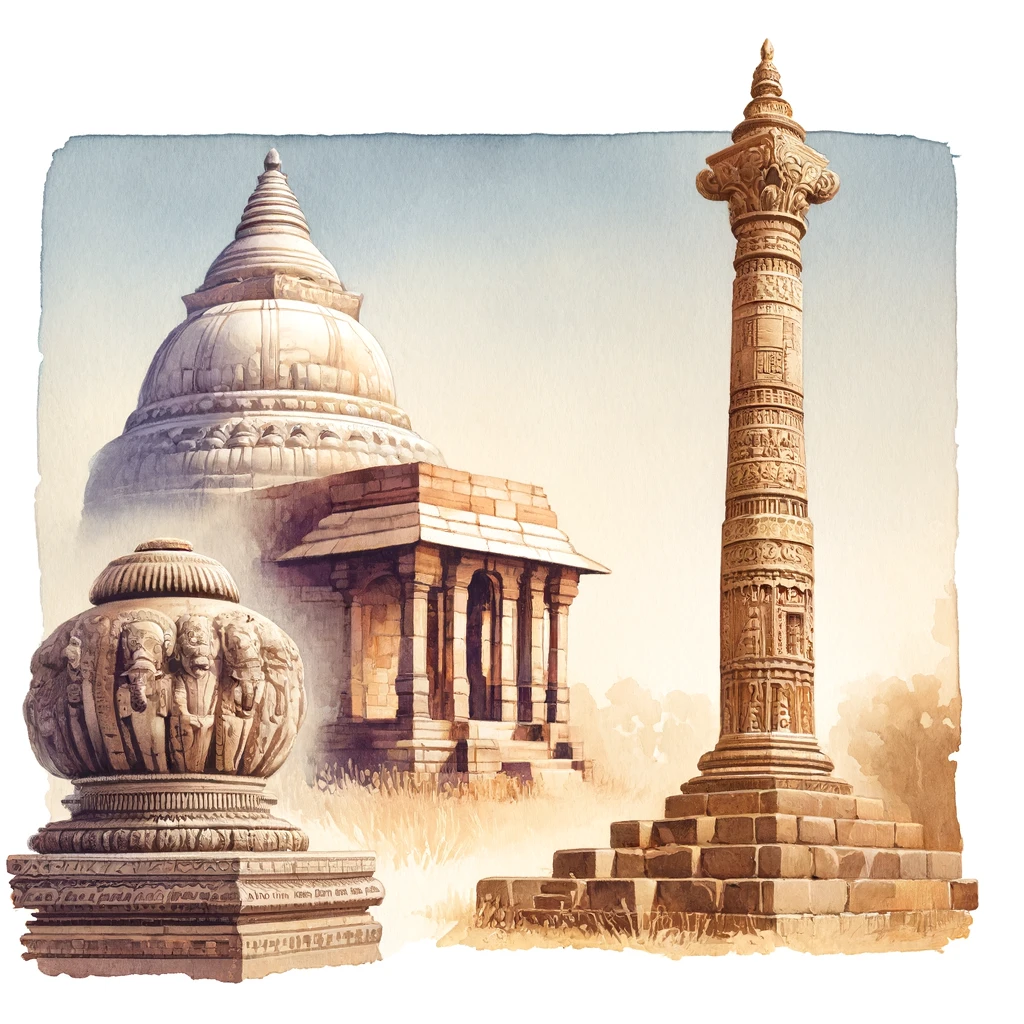The period following the decline of the Mauryan Empire saw significant political and cultural changes in India, marked by the arrival and rule of various foreign dynasties such as the Indo-Greeks, Shakas, Parthians, and Kushanas. These groups not only influenced the political landscape but also contributed significantly to the cultural and artistic development of the subcontinent, particularly through the Gandhara and Mathura schools of art.
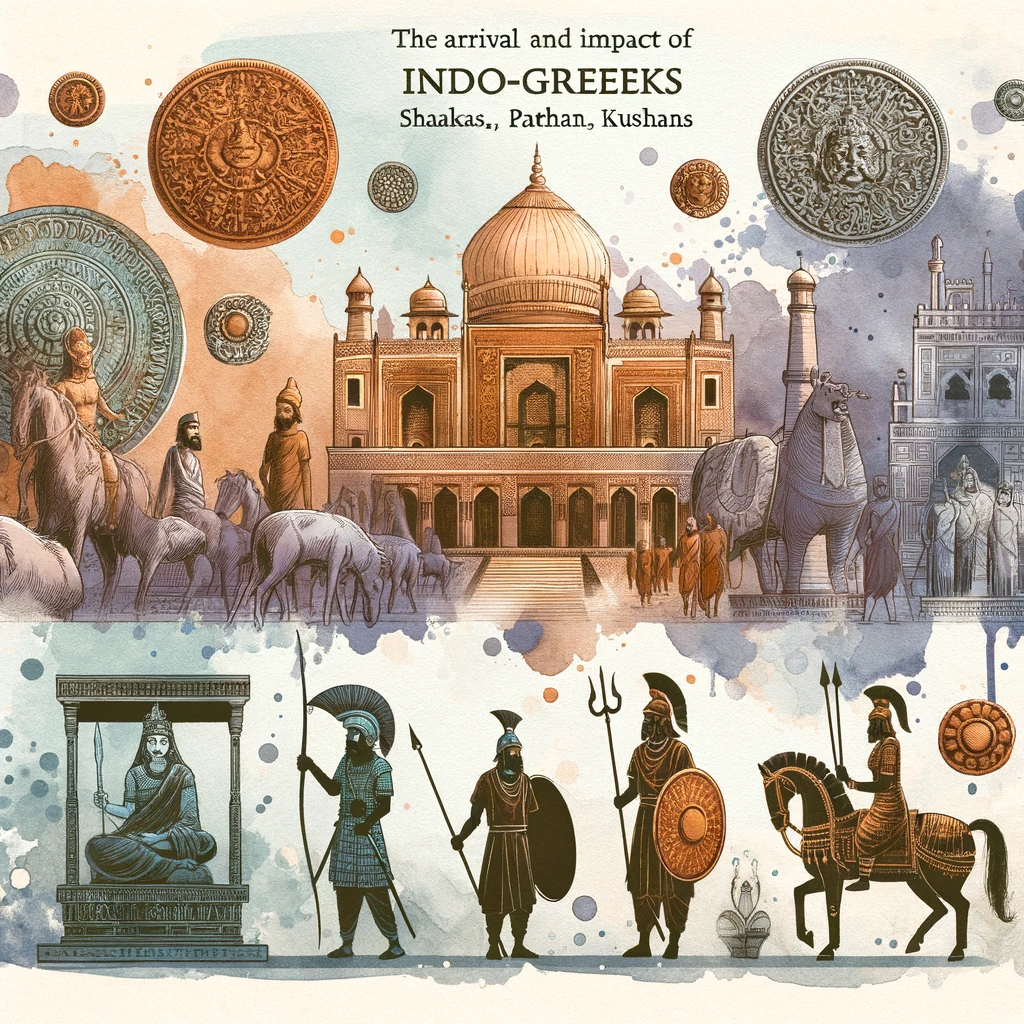
Political History and Cultural Interactions
Indo-Greeks
Political History
- The Indo-Greeks, also known as the Greco-Bactrians, began their incursion into northwestern India around 180 BCE. Their rule in India lasted until approximately the 1st century BCE.
- The most notable Indo-Greek ruler was Menander I (Milinda), who is known for his extensive realm and his conversion to Buddhism, as recorded in the Buddhist text “Milinda Panha” (The Questions of King Milinda).
Cultural Interactions
- The Indo-Greeks introduced Hellenistic cultural elements into Indian society, including advancements in coinage, art, and astronomy.
- They promoted the fusion of Greek and Indian cultural traditions, which is evident in their art and coinage, featuring Greek gods alongside Indian motifs.
Shakas (Scythians)
Political History
- The Shakas, originally from Central Asia, invaded and established their rule in northwestern India around the 1st century BCE. They controlled regions such as Gujarat, Maharashtra, and parts of western India.
- Prominent Shaka rulers include Maues (Moga) and Rudradaman I, who is known for his inscription at Junagadh.
Cultural Interactions
- The Shakas integrated into Indian society and adopted many local customs and traditions. They contributed to the cultural diversity of the region.
- Their rule saw the continuation and development of trade and urbanization, promoting economic prosperity.
Parthians
Political History
- The Parthians, also known as the Pahlavas, ruled parts of northwestern India during the 1st century CE. They succeeded the Indo-Greeks and were contemporaneous with the Shakas.
- Gondophares, the most famous Parthian ruler, is associated with the legend of St. Thomas the Apostle, who is believed to have traveled to India during his reign.
Cultural Interactions
- The Parthians continued the cultural syncretism initiated by the Indo-Greeks, blending Iranian and Indian elements.
- They patronized Buddhism and other local religions, fostering a multicultural environment.
Kushanas
Political History
- The Kushanas, originally from the Yuezhi tribe in Central Asia, established a powerful empire in northwestern India around the 1st century CE. Their rule extended over large parts of northern India, including the regions of present-day Pakistan, Afghanistan, and northern India.
- The most notable Kushana ruler was Kanishka I, under whose reign the empire reached its zenith. Kanishka is renowned for his patronage of Buddhism and his efforts to convene the Fourth Buddhist Council in Kashmir.
Cultural Interactions
- The Kushanas played a crucial role in promoting cultural exchanges between India, Central Asia, and China. Their empire served as a conduit for the transmission of ideas, art, and trade.
- They supported various religions, including Buddhism, Hinduism, and Zoroastrianism, and their rule is marked by religious tolerance and diversity.
Contribution to Indian Art and Architecture (Gandhara, Mathura Schools)
The post-Mauryan period saw significant developments in art and architecture, particularly through the Gandhara and Mathura schools of art. These schools reflected the cultural syncretism and artistic innovations of the time.
Gandhara School of Art
Characteristics
- The Gandhara school of art, which flourished in the northwestern region of the Indian subcontinent (modern-day Pakistan and Afghanistan), is renowned for its Greco-Buddhist art. It combined Hellenistic or Greco-Roman artistic techniques with Buddhist themes.
- The sculptures from Gandhara are characterized by realistic and detailed human figures, intricate drapery, and the use of stucco, stone, and terracotta.
Key Contributions
- The Gandhara school produced some of the earliest known depictions of the Buddha in human form, marking a significant departure from earlier aniconic representations.
- Iconic representations include the standing and seated Buddha statues, with features such as wavy hair, half-closed eyes, and detailed robes.
- The art from this school influenced Buddhist art across Asia, particularly in Central Asia and China.
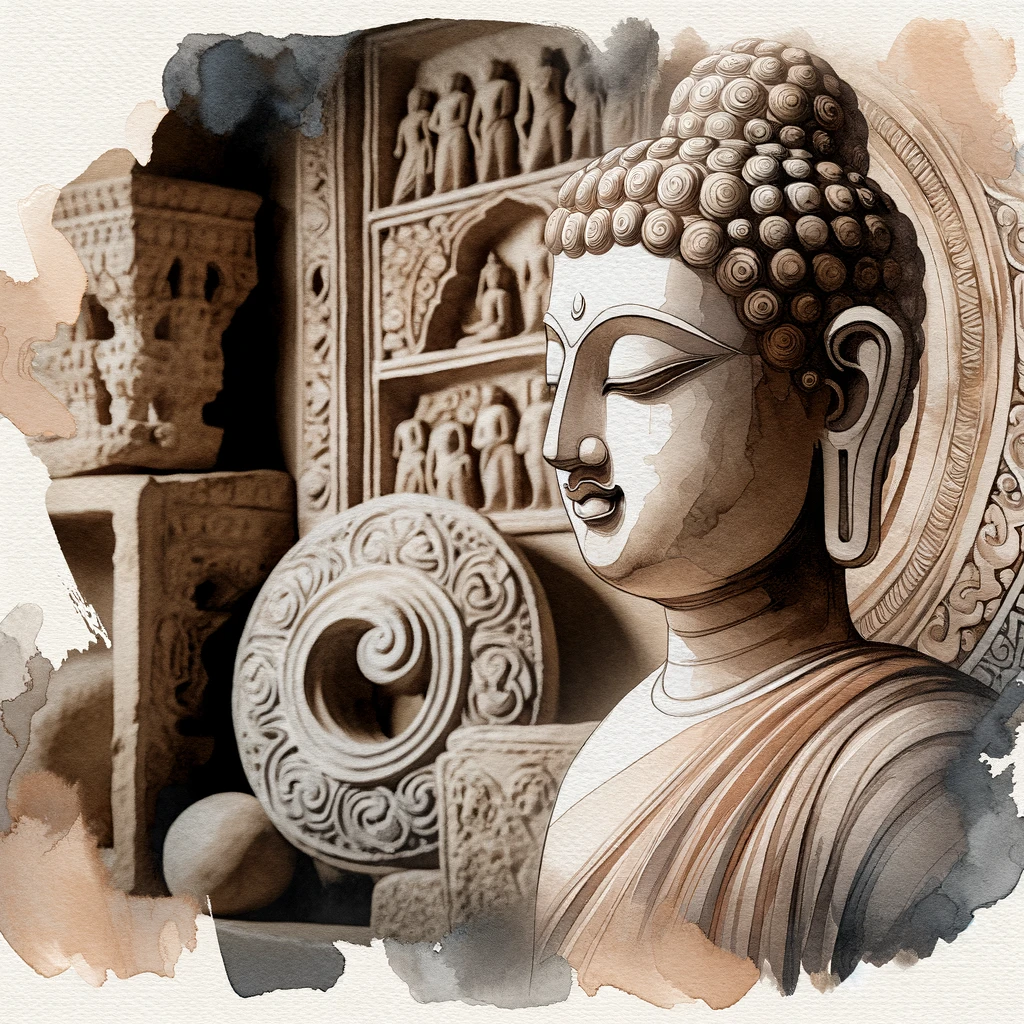
Mathura School of Art
Characteristics
- The Mathura school of art, centered in the region around Mathura in northern India, developed during the same period as the Gandhara school. It is known for its indigenous Indian style, focusing on robustness and dynamic expressions.
- The sculptures from Mathura are typically made from red sandstone and are characterized by their bold and sensuous forms, depicting deities, yakshas (nature spirits), and other religious figures.
Key Contributions
- The Mathura school contributed significantly to the development of Hindu, Buddhist, and Jain iconography. It produced some of the earliest images of Hindu gods such as Vishnu, Shiva, and their consorts.
- Mathura art also depicted the Buddha, often with more pronounced Indian features, such as broad shoulders and a slight smile, in contrast to the Hellenistic influences of Gandhara.
- The school is also known for its ornate reliefs and carvings on stupa railings and pillars, depicting scenes from Buddhist and Hindu mythology.
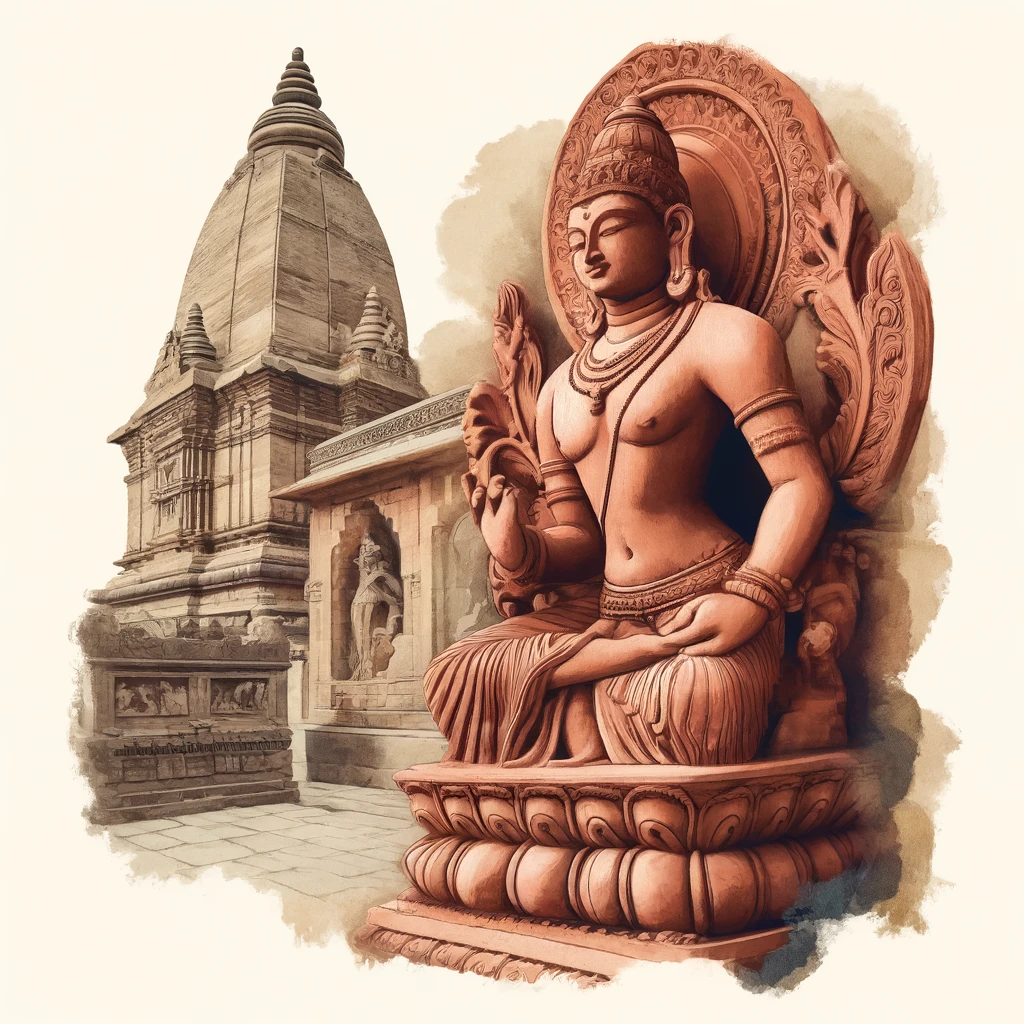
Influence on Subsequent Indian Art Forms
Cultural Fusion
- The Gandhara and Mathura schools set the stage for future artistic developments in India by integrating foreign artistic traditions with indigenous styles. This fusion led to the evolution of a distinctly Indian artistic tradition that continued to flourish in subsequent periods.
Spread of Buddhist Art
- The artistic innovations from these schools influenced the spread of Buddhist art across Asia, particularly in regions like Central Asia, China, Japan, and Southeast Asia. The depictions of the Buddha and other religious motifs from these schools became templates for Buddhist iconography in these regions.
Foundation for Gupta Art
- The artistic styles and iconographic conventions developed during the post-Mauryan period laid the groundwork for the Gupta period, which is often considered the golden age of classical Indian art. The Gupta period saw further refinement and perfection of the styles initiated by the Gandhara and Mathura schools.
Conclusion
The arrival and rule of the Indo-Greeks, Shakas, Parthians, and Kushanas in post-Mauryan India brought about significant political and cultural transformations. These dynasties contributed to the rich tapestry of Indian art and architecture, particularly through the development of the Gandhara and Mathura schools of art. The fusion of diverse artistic traditions during this period not only enriched Indian culture but also influenced artistic expressions across Asia. For UPSC aspirants, understanding the impact of these foreign dynasties and their contributions to Indian art and architecture is essential.

